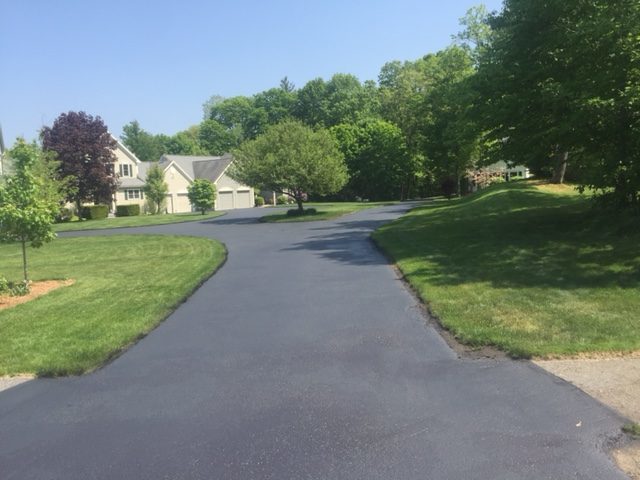Unleash the Possible: Regrading and Asphalt Sealing for Commercial Areas
Unleash the Possible: Regrading and Asphalt Sealing for Commercial Areas
Blog Article
Hot Mix Asphalt: A Sustainable Remedy for Pavement
Warm Mix Asphalt (HMA) has become a leading sustainable choice for pavement services, supplying a myriad of ingenious technologies and ecological benefits. Its capacity to reuse materials and decrease power intake provides a compelling instance for its adoption in roadway building tasks. The lasting performance and longevity of HMA make it a preferred choice for facilities advancement. As the demand for eco-friendly building and construction practices grows, checking out the nuances of HMA's sustainability can supply important understandings right into the future of sidewalk options.
Environmental Advantages of Hot Mix Asphalt

Additionally, Warm Mix Asphalt helps to minimize city warmth island results. Its dark shade soaks up sunlight, decreasing the amount of warmth mirrored back into the environment contrasted to lighter-colored sidewalks. This can reduce ambient temperature levels in city locations, decreasing the demand for a/c and inevitably reducing power intake.
Furthermore, Hot Mix Asphalt adds to enhanced stormwater monitoring. Its permeable nature enables water to recharge and infiltrate the pavement groundwater materials, reducing drainage and the threat of flooding. These ecological benefits make Hot Mix Asphalt a lasting choice for paving freeways and roads.
Power Efficiency in HMA Production
Is energy effectiveness a critical element in the production of Warm Mix Asphalt (HMA)? Energy plays a substantial role in the production of HMA, affecting both cost and ecological sustainability. One essential element of power performance in HMA production is the usage of cozy mix asphalt (WMA) technologies.
Furthermore, advancements in plant innovations have resulted in more energy-efficient HMA production processes. Modern plants are created with functions like recycled asphalt pavement (RAP) handling abilities, efficient heater systems, and boosted insulation, all adding to power financial savings. By enhancing energy use in HMA production, the sector can lower its carbon footprint while keeping top quality sidewalk products. Energy effectiveness is, for that reason, an essential consideration in ensuring the sustainability of Warm Mix Asphalt production.
Recyclability of Warm Mix Asphalt
The recyclability of Hot Mix Asphalt (HMA) is a crucial element of its sustainability and lasting environmental effect. HMA is just one of the most recycled products in the United States, with over 100 million lots of reclaimed asphalt pavement (RAP) being recycled yearly in brand-new sidewalk construction. Recycling HMA supplies several environmental advantages, such as decreasing the requirement for virgin materials, decreasing power usage throughout production, and reducing the amount of waste sent out to land fills.
The procedure of recycling HMA entails crushing the existing pavement, crushing it into smaller sized items, and mixing it with brand-new accumulation and asphalt binder to produce a recycled mix. This recycled mix can commonly execute in addition to and even better than conventional HMA, while needing less basic materials and generating reduced greenhouse gas discharges. By incorporating RAP into new pavement tasks, road agencies can save all-natural resources, decrease costs, and reduce the environmental footprint of road construction and maintenance activities. On the whole, the recyclability of HMA plays a substantial role in promoting sustainable methods within the pavement sector.

Long-Term Performance of HMA
Asphalt sidewalks demonstrate sturdiness and durability over a prolonged duration, mirroring the long-term performance of Hot Mix Asphalt (HMA) Full Report Furthermore, advancements in HMA innovation, such as the usage of polymer-modified binders and warm mix asphalt, have better improved the longevity and durability of HMA sidewalks. By prioritizing high quality building and construction and upkeep practices, HMA proceeds to verify itself as a cost-efficient and sustainable service for durable sidewalk infrastructure.

HMA: Toughness and Sustainability
Demonstrating both toughness and sustainability, Warm Mix Asphalt (HMA) has ended up being a cornerstone in the building of lasting pavement infrastructures - commercial parking lot paving. HMA's longevity stems from its capability to endure heavy tons, harsh climate condition, and high traffic quantities, making it a reliable option for roadways, freeways, and airport terminal paths. The structure of HMA, which commonly consists of accumulations, binder, and filler, plays a critical function in boosting its durability and resistance to tear and use
Furthermore, HMA's sustainability hinges on its recyclability and energy-efficient manufacturing process. The capability to recycle redeemed asphalt pavement (RAP) in new HMA blends useful link minimizes the need for virgin products and decreases the environmental influence of pavement building and upkeep. Furthermore, the power performance of generating HMA depends on its lower mixing temperatures contrasted to other pavement products, resulting in lowered energy consumption and greenhouse gas emissions.
Final Thought
In conclusion, warm mix asphalt (HMA) supplies a sustainable option for pavement with its environmentally friendly attributes. HMA's recyclability, power effectiveness in manufacturing, and long-term longevity make it an eco-friendly choice for roadway construction.
HMA is one of the most recycled products in the United States, with over 100 million bunches of recovered asphalt sidewalk (RAP) being reused every year in new pavement building and construction.The process of recycling HMA involves grating the existing sidewalk, crushing it into smaller sized pieces, and blending it with brand-new aggregate and asphalt binder to produce a recycled mix.Asphalt sidewalks demonstrate sturdiness and durability over a Check Out Your URL prolonged period, mirroring the long-term efficiency of Warm Mix Asphalt (HMA) Furthermore, innovations in HMA modern technology, such as the use of polymer-modified binders and warm mix asphalt, have actually better enhanced the resilience and long life of HMA sidewalks. The ability to reuse recovered asphalt pavement (RAP) in brand-new HMA mixtures decreases the need for virgin materials and reduces the ecological influence of pavement building and upkeep.
Report this page